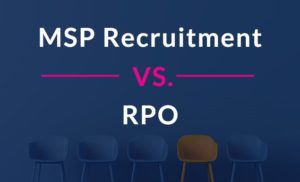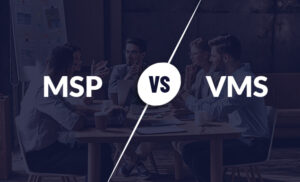Topics: MSP VMS Recruitment, VMS Recruiting
MSP Vs. VMS in Recruitment: What’s Best for Managing Contingent Labor?
Posted on February 26, 2024
Written By Ranjana Singh

In the realm of modern workforce management, the effective handling of contingent labor has become pivotal for businesses aiming to navigate dynamic market demands. Contingent labor, comprising freelancers, temporary workers, and contractors, plays a vital role in supplementing an organization’s core workforce.
Companies often turn to managed service providers (MSPs) and vendor management systems (VMS) to manage this contingent workforce efficiently.
Understanding the distinctions, functionalities, and benefits of each approach is key to optimizing the management of contingent labor.
What Managed Service Providers (MSPs)?
A Managed Service Provider (MSP) is a third-party entity that organizations engage to oversee and manage their contingent workforce or staffing needs. MSPs act as strategic partners, taking responsibility for the end-to-end management of contingent labor, which includes tasks such as recruitment, onboarding, vendor management, compliance, and performance monitoring.
MSPs offer expertise in workforce planning, compliance regulations, and vendor management, aiming to optimize the contingent labor process while aligning with the organization’s overall objectives and strategies. According to a study, organizations using MSPs reported an average cost savings of around 12-15% in their contingent labor management.
Key Features and Benefits of MSPs
1. Centralized Management: MSPs streamline the entire contingent labor process, serving as a single point of contact for all contingent workforce-related activities. This centralized approach enhances efficiency and consistency in managing diverse staffing needs.
2. Vendor Consolidation: MSPs engage and manage multiple staffing agencies on behalf of the client, consolidating vendor relationships. This ensures standardized processes, better pricing, and improved oversight of supplier performance.
3. Compliance and Risk Management: MSPs possess expertise in regulatory compliance and risk mitigation, ensuring that all contingent workers adhere to legal and industry-specific standards. They handle contracts, background checks, and other compliance-related tasks.
4. Data Analytics and Reporting: MSPs leverage data analytics to provide valuable insights into contingent labor performance, vendor efficiency, cost optimization, and workforce planning. This data-driven approach aids in strategic decision-making.
What are Vendor Management Systems (VMS)?
A Vendor Management System (VMS) is a technological platform designed to facilitate the efficient procurement and management of contingent labor for organizations. It serves as a centralized solution for the entire lifecycle of contingent workforce management. VMS recruitment platforms like QX Global Group provide tools for requisitioning, sourcing, engaging, and tracking contingent workers.
By enforcing standardized processes and compliance protocols, VMS platforms enhance efficiency, scalability, and decision-making in managing temporary and contract workers. VMS platforms were noted to reduce the time-to-fill metric by up to 20-30% for contingent workforce roles, streamlining the procurement process.
Key Features and Benefits of VMS
1. Automated Procurement: VMS platforms automate the process of procuring contingent labor, allowing for efficient requisition, vendor selection, and engagement. This streamlines the sourcing and hiring of temporary workers.
2. Enhanced Visibility and Control: VMS supports real-time visibility into contingent workforce activities, expenditures, and performance across multiple vendors and locations. This visibility allows for better control and decision-making.
3. Standardization and Compliance: VMS solutions enforce standardized processes and compliance protocols. They ensure that all engagements, contracts, and compliance requirements are consistently met across the contingent workforce.
4. Integration and Scalability: VMS platforms integrate with existing HR systems and can scale to accommodate varying workforce demands. They offer flexibility and adaptability in managing fluctuations in contingent labor needs.
VMS vs MSP in Recruitment: Choosing the Right Approach
The decision between utilizing an MSP or a VMS often hinges on an organization’s specific needs, structure, and objectives. In some cases, a combined approach known as a Hybrid MSP/VMS model might be preferred. Here’s a comparative analysis:
When to Choose an MSP?
1. Complex Workforce Needs: For organizations with intricate contingent labor requirements spanning various skill sets, industries, or geographical locations, an MSP offers comprehensive management and expertise.
2. Strategic Partnerships: When seeking a strategic partner to oversee the entire contingent workforce, from recruitment to compliance and performance management, an MSP’s end-to-end approach proves beneficial.
3. Compliance Emphasis: Industries with stringent regulatory compliance requirements, such as healthcare or finance, benefit from an MSP’s dedicated focus on compliance management.
When to Opt for a VMS?
1. Technology-Centric Solutions: Organizations inclined toward technology-driven solutions for efficient procurement, automation, and streamlined processes often favor VMS platforms.
2. Vendor Flexibility: For companies that prefer direct engagement with multiple staffing vendors and desire more control over individual engagements, a VMS offers flexibility and vendor diversity.
3. Scalability and Cost Control: VMS solutions are advantageous for businesses experiencing fluctuating contingent labor needs. They offer scalability options and tools for cost control and optimization.
Hybrid MSP/VMS Approach
Best of Both Worlds
The hybrid model capitalizes on the inherent advantages of MSPs and VMSs, merging their functionalities to create a more robust and flexible framework. By integrating the end-to-end management capabilities of an MSP with the technological efficiency of a VMS, organizations can enjoy the combined benefits.
This means having access to the extensive expertise, strategic oversight, and comprehensive management offered by MSPs while simultaneously harnessing the technological automation, scalability, and control features provided by VMS platforms.
Tailored Solutions
One of the key advantages of the hybrid approach lies in its adaptability and customization. Each organization has its unique requirements, workflows, and priorities. The hybrid model allows for a tailored solution that aligns precisely with these specific needs. It enables flexibility in utilizing the strengths of both MSPs and VMSs in a manner that best serves the organization’s objectives.
This customization ensures that the solution addresses the intricacies of the contingent workforce, compliance needs, vendor relationships, and overall workforce management strategy, providing a more finely tuned and effective approach.
Conclusion
In conclusion, the choice between MSP and VMS in recruitment or a hybrid model depends on an organization’s specific requirements, industry nuances, and strategic objectives. Both MSPs and VMS platforms offer distinct advantages in managing contingent labor, catering to different aspects of workforce management. Understanding these nuances is crucial for organizations seeking to optimize their contingent workforce management strategies and gain a competitive edge in today’s dynamic business landscape.
Frequently Asked Questions (FAQs)
What is an MSP?
An MSP is a third-party partner that manages an organization’s contingent workforce, handling tasks like recruitment, onboarding, compliance, and vendor management. They ensure streamlined processes and consistency across staffing agencies or suppliers.
What is a VMS?
A VMS is a technology platform that helps organizations efficiently procure and manage contingent labor. It provides tools for sourcing, engaging, and tracking workers, offering real-time visibility and enhancing efficiency in managing temporary staff.
What is VMS Support at QX Global?
VMS Support at QX Global involves tailored assistance in leveraging VMS solutions for efficient contingent labor management. It includes system integration, configuration, user training, maintenance, and continuous improvement to optimize VMS functionalities for effective workforce management.
Originally published Feb 26, 2024 12:02:58, updated Jan 17 2025
Topics: MSP VMS Recruitment, VMS Recruiting







